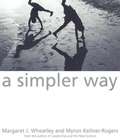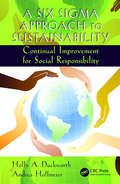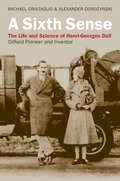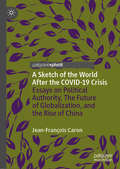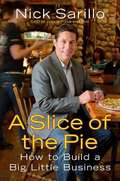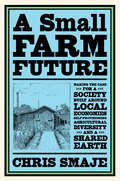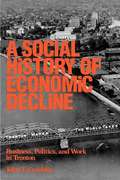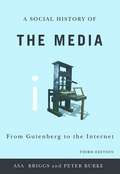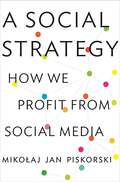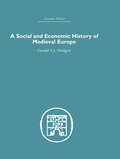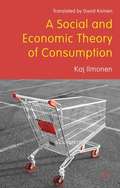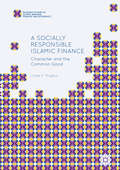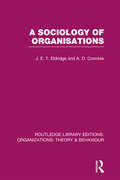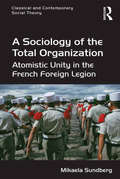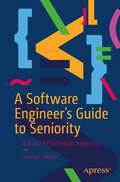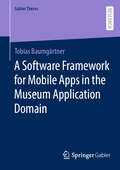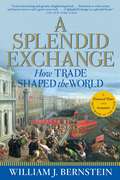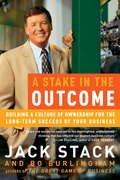- Table View
- List View
A Simple Stochastic Approach to Debt Sustainability Applied to Lebanon
by Edward Gardner Julian Di GiovanniA report from the International Monetary Fund.
A Simpler Way
by Margaret J. Wheatley Myron Kellner-RogersWe want life to be less arduous and more delightful. We want to be able to think differently about how to organize human activities. Our book springs from these desires. It explores a different way of thinking about life and about how organizing might occur. Our primary question is: How could we organize human endeavor if we developed different understandings of how life organizes itself? We ask this question for all of us, for there is no one who is unaffected by the organizations we humans have created.
A Six Sigma Approach to Sustainability: Continual Improvement for Social Responsibility (Systems Innovation Book Ser. #41)
by Holly A. DuckworthIn an age when most business plans extend only to the next quarterly reporting period, the authors of this book propose an audaciously longer view of future planning. Reaching beyond the modern five or ten-year strategic plan, the authors take a cue from Kongo Gumi, a Japanese construction company launched in 578 AD that managed to thrive as a fami
A Sixth Sense: The Life and Science of Henri-Georges Doll: Oilfield Pioneer and Inventor
by Michael Oristaglio Alexander DorozynskiThe true story of the French engineer and inventor who developed a mine detector for the US Army during WWII—and then went on to transform the oil industry. In March 1940, with Europe at war, French army lieutenant Henri-Georges Doll came to the U.S. embassy in Paris to give a deposition. Doll was an artillery commander, a graduate of France&’s grandes écoles of science, engineering, and service. He had been mobilized to the front at the start of the war, then quickly recalled to Paris to work on a secret device for detecting the deadly land mines being planted by the German army on a vast new scale. But Doll&’s deposition that day had nothing to do with the war. He had come to testify in a patent lawsuit pending in Houston, Texas. The case was Schlumberger Well Surveying Corporation v. Halliburton Oil Well Cementing Company: it marked one of the first great industrial battles for control of the technology of oil and gas exploration. When the German army marched into Paris three months later, Doll escaped to America, where he developed his new mine detector for the U.S. army, then settled in a small Connecticut town to become one of the most prolific inventors of the twentieth century. His sixth sense for applied science would help create the modern technology of seeing underground using electrical signals and sound waves—technology that would enable the explosive growth of oil production, and of Schlumberger, after the war. This biography tells his remarkable story.
A Sketch of the World After the COVID-19 Crisis: Essays on Political Authority, The Future of Globalization, and the Rise of China
by Jean-François CaronThis book tries to understand the lessons we ought to learn from the Covid-19 crisis as well as the profound transformations this pandemic will bring to the world order. These essays explore the challenge that the pandemic poses to liberalism, the unique potential this crisis offers us to retake control over globalization, and how it foreshadows future conflicts, especially the dynamic between China and the West. This timely book will be of interest to scholars in Political Science and philosophy, as well as to general readers interested in what the post Covid-19 world may resemble.
A Slice of the Pie: How to Build a Big Little Business
by Nick SarilloHow does a suburban pizza joint end up profiled on national magazine covers and network TV news? (Hint: The secret is not in the sauce. ) When Nick Sarillo decided to open a family-friendly pizza restaurant in the suburbs of Chicago, people thought he was nuts. Having worked as a carpenter for much of his adult life, he lacked any formal experience in restaurants or in managing a small business. Everyone told him no one else would ever care about his place the way he did. They warned he’d have to work 20-hour-days and monitor every employee just to stay in business. But Sarillo saw things differently, and set out to run his business in a radically different way. Today Nick’s Pizza & Pub is one of the top ten busiest independent pizza restaurants in the country, with two locations that gross about six times the revenue of the typical pizza restaurant. And in an industry where most employees leave within less than a year, Nick’s annual turnover rate is less than 20 percent. How did he do it? The secret lies in Nick’s purpose-driven culture, in which every employee—from the waiters to the chefs to the managers—is equipped with the tools necessary to do their jobswhile also advancing the company’s overall mission. The result is higher sales, a dedicated team, and a big little business that is beloved by the entire community. In A Slice of the Pie Sarillo tells the story of how he built his extraordinary culture and shows how anyone can follow his methods. For instance, Nick’s managers engage the staff by tracking and rewarding unusual metrics, such as how many guests request a particular server or the average check amount of each carryout host. Likewise, team members of all ages and levels of experience are encouraged to express themselves, acquire new skills, and suggest ideas to help the business grow. A Slice of the Pie will help transform even the smallest, simplest, and most ordinary business into a successful, high-performance organization. .
A Small Farm Future: Making the Case for a Society Built Around Local Economies, Self-Provisioning, Agricultural Diversity and a Shared Earth
by Chris SmajeIn a time of looming uncertainties, what would a truly resilient society look like? In a groundbreaking debut, farmer and social scientist Chris Smaje argues that organising society around small-scale farming offers the soundest, sanest and most reasonable response to climate change and other crises of civilisation—and will yield humanity’s best chance at survival. Drawing on a vast range of sources from across a multitude of disciplines, A Small Farm Future analyses the complex forces that make societal change inevitable; explains how low-carbon, locally self-reliant agrarian communities can empower us to successfully confront these changes head on; and explores the pathways for delivering this vision politically. Challenging both conventional wisdom and utopian blueprints, A Small Farm Future offers rigorous original analysis of wicked problems and hidden opportunities in a way that illuminates the path toward functional local economies, effective self-provisioning, agricultural diversity and a shared earth.
A Small Farm Future: Making the Case for a Society Built Around Local Economies, Self-Provisioning, Agricultural Diversity and a Shared Earth
by Chris SmajeA modern classic of the new agrarianism"Chris Smaje...shows that the choice is clear. Either we have a small farm future, or we face collapse and extinction."—Vandana Shiva"Every young person should read this book."—Richard HeinbergIn a groundbreaking debut, farmer and social scientist Chris Smaje argues that organizing society around small-scale farming offers the soundest, sanest and most reasonable response to climate change and other crises of civilisation—and will yield humanity&’s best chance at survival.Drawing on a vast range of sources from across a multitude of disciplines, A Small Farm Future analyses the complex forces that make societal change inevitable; explains how low-carbon, locally self-reliant agrarian communities can empower us to successfully confront these changes head on; and explores the pathways for delivering this vision politically.Challenging both conventional wisdom and utopian blueprints, A Small Farm Future offers rigorous original analysis of wicked problems and hidden opportunities in a way that illuminates the path toward functional local economies, effective self-provisioning, agricultural diversity and a shared earth.Perfect for readers of both Wendell Berry and Thomas Piketty, A Small Farm Future is a refreshing, new outlook on a way forward for society—and a vital resource for activists, students, policy makers, and anyone looking to enact change.
A Social Critique of Corporate Reporting: Semiotics and Web-based Integrated Reporting (Routledge Revivals Ser.)
by David CrowtherIn the critically acclaimed first edition of A Social Critique of Corporate Reporting, David Crowther examined the perceived dialectic around traditional and environmental reporting to show it to be a false dialectic. Corporate reporting continues to change rapidly to incorporate more detail and especially environmental and social information. At the same time the mechanism for reporting has changed and the internet now enables more information to be provided to an ever wider range of stakeholders and interest groups. The perceived conflict between financial performance representing the needs of investors and other dimensions of performance representing the needs of other stakeholders still however continues to exist. In this updated edition, this perceived conflict is re-examined along with the wider purposes of corporate reporting. These are examined in the context of web based reporting and a greater concern for all stakeholders. The conclusion is that, although recent developments have produced changes, the essential conflict is still professed to exist, but remains a largely imaginary one. The analysis in this book makes use of both statistics and semiotics and in so doing develops a semiology of corporate reporting that offers an alternative to other research that is largely based on econometrics. Researchers, higher level students and others with an interest in or responsibility for corporate reporting, corporate social responsibility, accounting research, or semiotics will find this book essential reading.
A Social History of Economic Decline: Business, Politics, and Work in Trenton
by John T. CumblerBusiness, Politics, and Work in Trenton (Class & Culture)
A Social History of the Media: From Gutenberg to the Internet,
by Asa Briggs; Peter BurkeIncreased space is given to the exciting media developments of the early 21st Century, including in particular the rise of social and participatory media and the globalization of media. Additionally, new and important research is incorporated into the classic material exploring the continuing importance of oral and manuscript communication, the rise of print and the relationship between physical transportation and social communication.
A Social Strategy: How We Profit from Social Media
by Mikolaj Jan PiskorskiWhat people get out of social media—and how businesses can get more out of itAlmost no one had heard of social media a decade ago, but today websites such as Facebook, Twitter, and LinkedIn have more than 1 billion users and account for almost 25 percent of Internet use. Practically overnight, social media seems indispensable to our lives—from friendship and dating to news and business.What makes social media so different from traditional media? Answering that question is the key to making social media work for any business, argues Miko?aj Piskorski, one of the world's leading experts on the business of social media. In A Social Strategy, he provides the most convincing answer yet, one backed by original research, data, and case studies from companies such as Nike and American Express.Drawing on his analysis of proprietary data from social media sites, Piskorski argues that the secret of successful ones is that they allow people to fulfill social needs that either can’t be met offline or can be met only at much greater cost. This insight provides the key to how companies can leverage social platforms to create a sustainable competitive advantage. Companies need to help people interact with each other before they will promote products to their friends or help companies in other ways. Done right, a company’s social media should benefit customers and the firm. Piskorski calls this "a social strategy," and he describes how companies such as Yelp and Zynga have done it.Groundbreaking and important, A Social Strategy provides not only a story- and data-driven explanation for the explosion of social media but also an invaluable, concrete road map for any company that wants to tap the marketing potential of this remarkable phenomenon.
A Social View of Socotra Island: People, Culture, Heritage
by Nataša Slak Valek Ahmad Abdelmoniem ZedanThis book focuses on Socotra Island, geographically based in Yemen, and aims to explore the island from the social sciences point of view. This book focuses on people indigenous to Socotra, Socotri cultures, heritage and also offers contributions from business, tourism, linguistic, communication, and anthropology. While a lot has been published in natural science about Socotra’s endemic species, biodiversity, and nature in general, social scientific research of the island is very limited. This book addresses therefore addresses this gap and explores various topics of tourism, behaviours, cultures, and language.This book focuses on a clear social science approach of Socotra. The purpose of this book is to publish research about the people, behaviors, heritage, and potential tourism of Socotra. The Socotra Archipelago has long been a land of mystery. It is unknown as a tourism destination for many, however, is a popular destination for adventurers, photographers and travelers who like to travel to remote and undeveloped places. This book explains how Socotra has limited resources of electricity, which is provided by diesel generators, Internet is very slow and limited to certain points on the island. There are no shopping malls or five-star hotels. Roads, schools, and hospitals have been built only recently. This book shoes how these island people do not know the development as we do, which makes it principally interesting to research. Previous interviewers of Socotri people about tourism development in the island have faced many challenges such as language barriers, lack of understanding the meanings and interviewing content, lack of support for the anticipated research results. This book successfully undertakes this challenge as not only in understanding the language, but understanding phenomena like e.g. tourism. Whilst acknowledging the ways in which indigenous island people have never travelled or seen a developed city. Thus, words like ‘developed’, ‘tourism destination’ or ‘washing machine’ may be unfamiliar terms for them. Therefore, new and innovative research methods that are sensitive to Socotra people were implemented in the creation of this book.
A Social and Economic History of Medieval Europe
by Gerald A. HodgettThis excellent and concise summary of the social and economic history of Europe in the Middle Ages examines the changing patterns and developments in agriculture, commerce, trade, industry and transport that took place during the millennium between the fall of the Roman Empire and the discovery of the New World. After outlining the trends in demography, prices, rent, and wages and in the patterns of settlement and cultivation, the author also summarizes the basic research done in the last twenty-five years in many aspects of the social and economic history of medieval Europe, citing French, German and Italian works as well as English. Significantly, this study surveys the present state of discussion on a number of on unresolved issues and controversies, and in some areas suggests common sense answers. Some of the problems of economic growth, or the lack of it, are looked at in the light of current theories in sociology and economic thought. This classic text, first published in 1972, makes a useful and interesting general introduction for students of medieval and economic history.
A Social and Economic Theory of Consumption
by Kaj IlmonenKaj Ilmonen was a pioneer in the third wave of the sociology of consumption. This book provides a balanced overview of the sociology of consumption, arguing that the enthusiasm of 'the third wave' exaggerated the role of the symbolic and imaginary at the expense of the materiality of human societies.
A Socially Responsible Islamic Finance: Character and the Common Good (Palgrave Studies in Islamic Banking, Finance, and Economics)
by Umar F. MoghulThis book explores how, through spirituality and the development of character, Islamic financial institutions and Muslim communities can integrate their businesses with contemporary social responsibility initiatives to produce positive social and environmental impact. From the looming environmental crisis to the divide between mainstream and extremist interpretations of Islam, the book addresses significant questions facing Muslim communities - and humanity - and demonstrates why Islam should sit 'at the table' with other faiths and ethical traditions discussing humanity's great obstacles. Unlike existing literature, this work explores the intersections between classical Islamic ethics and spirituality, contemporary Islamic finance and economic markets, and select sustainability and impact initiatives (such as the Equator Principles and UN Principles of Responsible Investment) designed to make the worlds of business and finance responsible for the environments in which they operate and the communities that support them. Drawing on his years of experience in Islamic banking, Moghul addresses these applications in light of real-world practices and dilemmas, demonstrating how Islamic organizations and Muslim communities should embrace the broad range of stakeholders countenanced by the Shari'ah in conversations that affect them. By situating his exploration of Islamic finance in the light of the much larger critical issues of balance, justice, and moderation in Islamic praxis, Moghul creates an interdisciplinary book that will appeal to academics and researchers in economics, finance, business, government and policy, and law.
A Sociology of Organisations (Routledge Library Editions: Organizations)
by J. E. Eldridge A. D. CrombieAn understanding of the nature and forms of organisation, particularly with reference to industrial societies, is a key area in sociological analysis. This book discusses and explains what concepts to employ and what analytical procedures to adopt as well as conveying a sense of the theoretical and empirical diversity involved in the study of organisations. Among the questions explored are: why do we classify organisations in particular ways and for what purpose? how can on explore the relationships pertaining to an organisation and its environment? what issues are raised by the existence of many varied and often competing organisations in industrial societies?
A Sociology of the Total Organization: Atomistic Unity in the French Foreign Legion (Classical and Contemporary Social Theory)
by Mikaela SundbergExamining the organization of everyday life inside the regiments of the French Foreign Legion, this book takes its theoretical point of departure in the notion of the voluntary total organization; that is to say, an institution that constitutes a geographically delimited place of residence and work in which inmates are voluntarily separated from the outside world, leading an enclosed, formally administered life. Informed by a modified version of Goffman's original concept of the total institution, A Sociology of the Total Organization untangles the Foreign Legion and the ways in which different kinds of social orders interplay there. With a focus on regimental life, the author characterizes the armed forces not only as a total organization, but also as a greedy one, seeking undivided loyalty and the incorporation of all social roles within its bounds. Against this understanding, the book draws on rich ethnographic work to develop the notion of atomistic unity, the ideal relational condition that exists in the military, in which individuals commit to a unit and articulate ties with individuals on an impersonal basis, grounded in the belief in a greater whole. A detailed and empirically grounded study of the mechanisms in which the Foreign Legion not only cuts members' ties to people outside the organization, but also restricts the creation and maintenance of ties among its members, this book shows how atomistic unity is not limited to greedy organizations such as the military, but applies to a variety of collectivist settings. As such, it will appeal to scholars of sociology and anthropology with interests in military life, social relations, social theory and the work of Goffman.
A Software Development Approach for Driving Competitiveness in Small Firms
by Delroy CheversThe COVID-19 Pandemic has forced many businesses to accelerate their digital transformation strategies to continue to meet the changing needs of their customers. This has resulted in significant growth in the global software market. However, for decades, managing software product quality has been a major challenge for many software development firms. This low success rate is due mainly to the development and delivery of low-quality software products. In addition to the direct costs associated with poor-quality software, software flaws can also raisesecurity concerns, as hackers can gain complete control of various devices and data, such as mobile phones, computers, or the operational transactions of businesses. These security and privacy breaches are currently occurring with great frequency. Although producers and consumers of software products spend vast amounts of money developing and purchasing these products, in many cases the promised benefits of user satisfaction, efficiency, productivity and profitability are not realized. In more severe circumstances, software development firms have failed and face the threat of going bankrupt, being acquired or suffering closure, because customers are demanding high-quality software products that they consistently fail to deliver. Small and medium enterprises (SMEs) operating within the software development industry have a more critical need to produce high-quality software since they are less able to absorb both the cost and the reputational impact of producing low-quality output. A Software Development Approach for Driving Competitiveness in Small Firms provides some cost-efficient options that can help SMEs increase the likelihood that their software will be of high quality. It tells the story of the entrepreneurial journey that small firms should take to deliver high-quality software products. By utilizing practical examples and providing several recommended solutions to decrease the likelihood of producing low-quality software, the book outlines how mobilizing people, processes and technology are integral to the software development process and emphasizes why process maturity is the most influential factor in software development in small and medium enterprises.
A Software Engineer’s Guide to Seniority: A Guide to Technical Leadership
by Jocelyn HarperThere are few books in the market that talk about the effort within and outside of the job that helps software engineers advance in their careers. This book is a truthful and introspective look at technical careers and a consolidation of that information and advice for engineers that are looking to elevate their career to the senior level. While charting a path to becoming a senior software engineer you'll study how to handle the obligations and complexities involved in that role. While most of the software engineer job is exploratory and involves learning new things nearly every day, this book will show you how to be a manager, a leader, and to achieve seniority in your tech role. From learning how to optimize your resume to knowing how to interview for positions on your team to helping your team grow and develop their own skills and career, this is a book that all software engineers need. What You'll LearnOptimize your resume for applicationsStandard tips for interviewing in software engineer positionsBecome a mentor and leader at your jobWho This Book Is ForEntry to mid-level software engineers working in a corporate environment
A Software Framework for Mobile Apps in the Museum Application Domain (Gabler Theses)
by Tobias BaumgärtnerThis book is concerned with “How to provide guidance for small cultural heritage institutions to govern digital transformation, and how to align the possibilities with the available capabilities by creating a Software Framework for Mobile Apps in the Museum Application Domain?”. The role of the museum has shifted from a keeper of artifacts to a provider of information. In this context mobile applications are intended to generate added value for the museum visitor. However, the tension between the application’s creator, its content, and the consumer operating the app needs to be examined holistically. As it is not trivial to create an integrated user experience, the unique usability-centered perspective on the requirements engineering pursued throughout, allows for the suggested data-driven solution to address the specific domain issues and serve the intended audience. Based on the insights gained during this examination and under the utilization of design science research, human-centered design, and domain-driven design “A Software Framework for Mobile Apps in the Museum Application Domain” is created and implemented using web technologies.
A Soul and a Service: North Carolina Mutual Life Insurance
by Tom Nicholas John MaskoIn 1898, two Black entrepreneurs from Durham, North Carolina-barber John Merrick and medical doctor Aaron McDuffie Moore-put pen to paper and founded the North Carolina Mutual and Provident Association (the Mutual). They would soon be joined by a third partner-an energetic young salesman named Charles Clinton Spaulding. This "triumvirate" faced long odds. While there was a long tradition of Black mutual aid societies-religious organizations that charged dues and paid members a small sum in the event of a death or emergency-operating a for-profit insurance company catering to the Black community presented several challenges. By the 1890s, an increasing number of Southern Blacks had the resources to afford a basic life insurance policy, but few had experience buying life insurance or knew why it was necessary.
A Space of Quiet: Create Moments of Serenity in Order to See Management Dilemmas Clearly
by Joseph L. Badaracco Jr.Managers everywhere are under pressure to provide answers now. As a result, when they must choose between right and right, managers often have little opportunity to step back and reflect on the complexity of the issues. This chapter examines the hazards of such situations, provides theoretical and practical insight into how managers can effectively deal with these pressures, and describes how they can cultivate the art of reflection that will help guide them through the decision making landscape. This chapter is excerpted from "Defining Moments: When Managers Must Choose between Right and Right."
A Splendid Exchange: How Trade Shaped the World
by William J. BernsteinWhile many historians and economists have contended that globalization began in the 21st century, financial theorist and historian Bernstein argues that the phenomenon began substantially earlier and has evolved over time. The author asserts that globalization had its true beginnings in the operations of the English and Dutch East India companies, and delves into the history and frequently complex mechanisms of trade among nations. He also makes it abundantly clear that while trade has improved the overall welfare of mankind, it also created great disparities of wealth and its attendant consequences. An interesting and very readable book. Annotation ©2009 Book News, Inc. , Portland, OR (booknews. com)
A Stake in the Outcome: Building a Culture of Ownership for the Long-Term Success of Your Business
by Jack Stack Bo BurlinghamThe First Management Classic of the New Millennium!A bold experiment is taking place these days, as leading-edge companies turn upside down the management paradigm that has dominated corporate thinking for more than one hundred years. Southwest Airlines is perhaps the most visible practitioner, soaring through economic downturns while its competitors slash their budgets and order massive layoffs, but you can find other pioneers of the new approach in almost every industry and market niche. Their secret: a culture of ownership that allows them to tap into the most underutilized resource in business today-namely, the enthusiasm, intelligence, and creativity of working people everywhere.No one knows more about building a culture of ownership than CEO Jack Stack, who's been working on one for the past twenty years with his colleagues at SRC Holdings Corporation (formerly Springfield ReManufacturing Corporation). Along the way, they've turned their company into what Business Week has called a "management Mecca," attracting thousands of people representing hundreds of businesses to SRC's home in Springfield, Missouri. There the visitors learn how to incorporate the ideals and values of SRC's remarkable corporate culture into their own organizations-and then they go back and do it.Now, in A Stake in the Outcome, Stack offers a master class on creating a culture of ownership, presenting the hard-won lessons of his own twenty-year journey and explaining what it really takes to build for long-term success. The pioneer of "open-book management" (described in the best-selling classic The Great Game of Business), Stack and twelve other managers began their journey in 1982, when they purchased their factory from its struggling parent company. SRC grew 15 percent a year, while adding almost a thousand new jobs, and the company's stock price rocketed from 10 cents to $81.60 per share. In the process, Stack discovered that long-term success required constant innovation-and that building a culture of ownership involved much more than paying bonuses, handing out stock options, or setting up an employee stock ownership plan. In a successful ownership culture, every employee had to take the fate of the company as personally as an individual owner would. Achieving that level of commitment was extraordinarily difficult, but Stack realized that the payoff would be enormous: a company that was consistently able to outperform the market.A Stake in the Outcome isn't about theory-it's about practice. Stack draws from his own successes and failures at SRC to show how any company can teach its employees to think and act like owners, including how to implement an effective equity-sharing program, how to promote continuous learning at every level of the organization, how to fire up employees' competitive juices, how to broaden the concept of leadership and delegate responsibility for the business, and how to build a workforce that is fast on its feet and ready to take advantage of every opportunity. You'll also learn about other companies that have succeeded in building cultures of ownership-and the lessons they can teach the rest of us.Written in Jack Stack's straightforward, witty, no-beating-around-the-bush style, A Stake in the Outcome is like having a one-on-one session with a master entrepreneur and business innovator. It shows managers and executives of companies both large and small how to build a ferociously motivated workforce that is energized and committed to meeting and overcoming the most daunting challenges a company can face.From the Hardcover edition.

